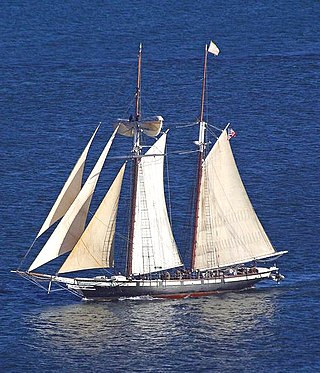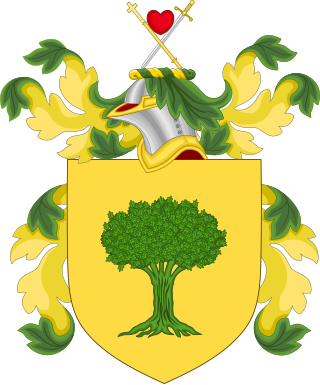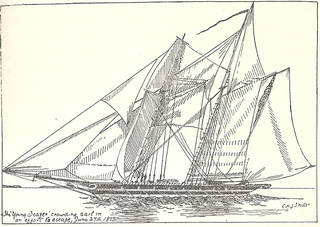Sir John Sherbrooke was a successful and famous Nova Scotian privateer brig during the War of 1812, the largest privateer from Atlantic Canada during the war. In addition to preying on American merchant ships, she also defended Nova Scotian waters during the war. After her conversion to a merchantman she fell prey to an American privateer in 1814. She was burnt to prevent her reuse.

The Pride of Baltimore was a reproduction of a typical early 19th-century "Baltimore clipper" topsail schooner, commissioned to represent Baltimore, Maryland. This was a style of vessel made famous by its success as a privateer commerce raider, a small warship in the War of 1812 (1812–1815) against British merchant shipping and the world-wide British Royal Navy. After the end of the war, Baltimore Clippers did not have sufficient cargo capacity for normal merchant trade, so some were used in the illegal opium trade into China and vessels of the same type were used in the transatlantic slave trade from Africa.

A Baltimore clipper is a fast sailing ship historically built on the mid-Atlantic seaboard of the United States of America, especially at the port of Baltimore, Maryland. An early form of clipper, the name is most commonly applied to two-masted schooners and brigantines. These vessels may also be referred to as Baltimore Flyers.

HMS Duke of Gloucester was a 10-gun brig of the Royal Navy which was launched at the Kingston Royal Naval Dockyard in Kingston, Ontario. A Provincial Marine vessel, during the War of 1812, the brig took part in several of the early engagements between British and American naval forces on Lake Ontario and the St. Lawrence River. While being repaired at York, Duke of Gloucester was captured by Americans in 1813. A month later the British destroyed the brig at the Battle of Sackett's Harbor.

Thomas Boyle, an Irish American, as a captain of the schooner Comet and the clipper Chasseur, was one of the most successful Baltimore privateers during the War of 1812. He briefly served in the United States Navy during the same war.

HMS Belvidera was a Royal Navy 36-gun Apollo-class frigate built in Deptford in 1809. She saw action in the Napoleonic Wars and the War of 1812 and continued a busy career at sea into the middle of the 19th century. In 1846 she was reduced to harbour service, in 1860 she became a receiving ship, and she was finally disposed of in 1906.
USS Gallatin was a post-Revolutionary War sailing vessel that the U.S. Department of the Treasury purchased at Norfolk, Virginia, for the United States Revenue-Marine in December 1807. An explosion on board destroyed her in 1813.

Young Teazer was a United States privateer schooner that captured 12 British vessels, five of which made it to American ports. A member of her crew blew her up at Mahone Bay, Nova Scotia during the War of 1812 after a series of British warships chased her and after HMS Hogue trapped her. The schooner became famous for this deadly explosion, which killed most of her crew, and for the folklore about the ghostly "Teazer Light."

HMS St Lawrence was a 14-gun schooner of the Royal Navy. She had been built in 1808 in St. Michaels, Talbot County, Maryland for Thomas Tennant and sold to Philadelphians in 1810. During the War of 1812 she was the US privateer Atlas. The UK captured her in 1813 and renamed her St Lawrence. The US privateer Chasseur recaptured her in 1815, and then HMS Acasta re-recaptured her.
HMS Anaconda was an 18-gun brig-sloop of the Royal Navy during the War of 1812. She was cruising as an American privateer until sailors from HMS Sceptre captured her in 1813. She served briefly in the Royal Navy during the later stages of the War of 1812, especially at the Battle of New Orleans, before being sold in Jamaica in 1815.
HMS Canso was the American letter of marque schooner Lottery, launched in 1811, that a British squadron captured in 1813. The Royal Navy took Lottery into service as HMS Canso and she served during the War of 1812 and briefly thereafter. The navy sold her in 1816.

HMS Moselle was a Cruizer-class brig-sloop of the Royal Navy, launched in 1804. She served during the Napoleonic Wars in the Mediterranean, the Caribbean, and the North American station. She was sold in 1815.
Surprise was a highly successful American privateer schooner. She was launched in 1813 and operated out of Baltimore. She captured over 40 British vessels during her brief career. In one case the capture followed a single-ship action. She was wrecked in April 1815, shortly after the end of the War of 1812.
Invincible Napoleon was a three-masted French privateer commissioned in Bayonne in Spring 1804. She made numerous cruises until 1813–1814 when the British and the Americans repeatedly captured her. In her brief career as an American privateer she captured some 14 vessels. She finally ended up in British hands and was taken to Halifax, Nova Scotia as a prize.

Babiole was a French privateer launched at La Ciotat in 1811. She made four cruises between 1811 and 1813 in the Mediterranean as a privateer, capturing a number of prizes. The British Royal Navy captured her in 1815. She might have been a balaou, a type of schooner.

Comet, an American schooner, was built in 1810 at Baltimore, Maryland. She was owned by "a group of wealthy Baltimore investors." Under Captain Thomas Boyle, who was a part owner of the schooner, Comet sailed from July 1812 to March 1814 as a privateer, which was a type of ships licensed by the United States during the War of 1812 to harass the British merchant vessels and divest their cargoes.
HMS Barbadoes was a 16-gun vessel, the American Herald, captured in 1813. The Royal Navy took her into service as HMS Barbadoes She captured a number of merchantmen and privateers before she was paid-off in May 1816. In 1814–1815 she also captured three Spanish and French slave ships carrying over 1100 enslaved people. Barbadoes became a powder ship in Jamaica that was later wrecked with her remains being sold.










